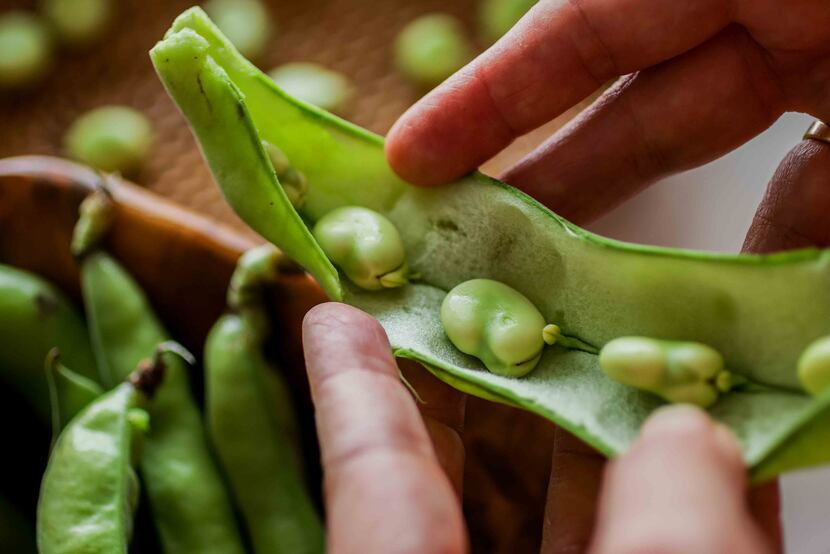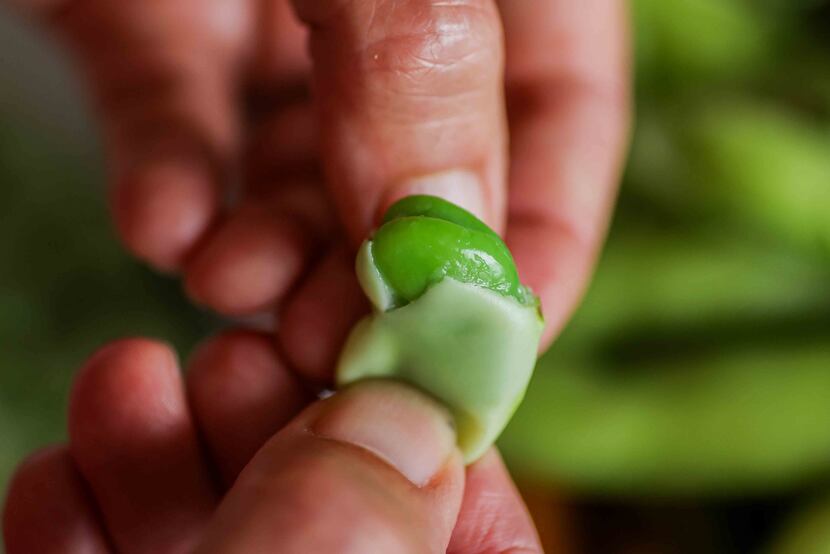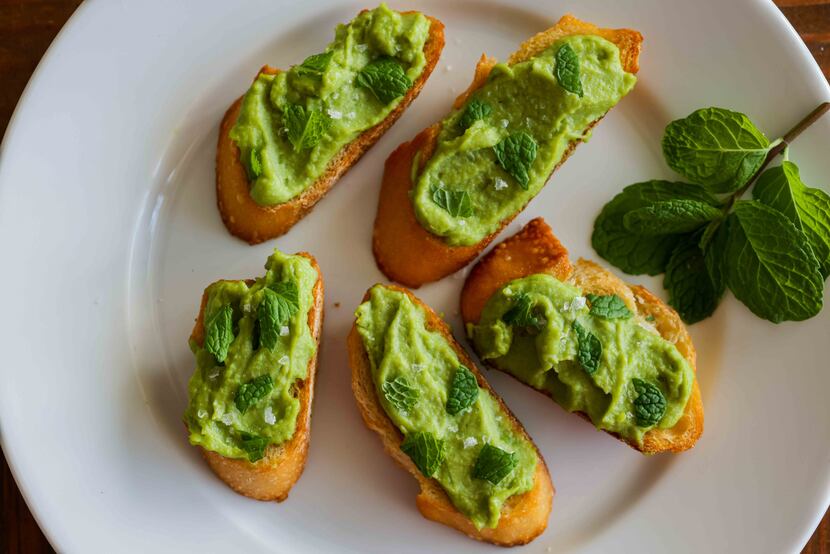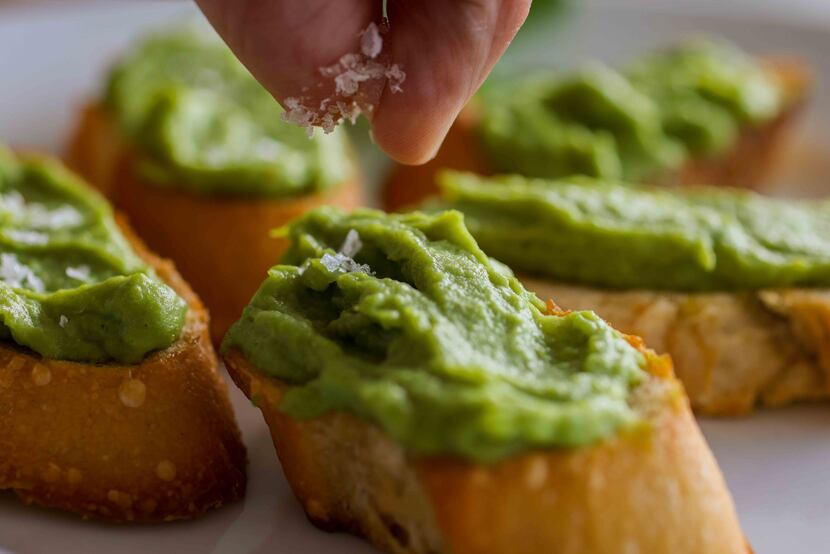Fresh fava beans — a spring delicacy — have returned to local restaurant menus in sublime specials. Lucia featured a fava bean agnolotti at its grand re-opening last weekend, and Nonna features fusili with herbed fava bean pesto this week. Both of these dishes are tossed with tender whole fava beans as well.
You don’t need chef-level skills to prepare favas at home, though. The beloved beans are surprisingly simple to cook, but until recently, they were hard to find in markets. Now, fresh fava bean pods are sold at Jimmy’s Food Store through April, and at Central Market on Lovers Lane. They’re at their peak now, so get them while you can.
Fava beans — also known as broad beans — are prized for their tender, buttery texture and sweet, nutty flavor. Although in Tuscany, fresh fava beans are often eaten raw, stateside they’re usually cooked, in dishes ranging from pastas to hummus-like purées. For raw consumption, freshly shelled young beans are essential; they’re hard to come by though, so resign yourself to at least blanching the more mature beans. Two pounds of fava bean pods will yield about 2 cups of shelled beans.

Although easy to cook, fava beans require lots of prep work: opening the pods to release the beans from their fuzz-lined jackets; blanching the beans and chilling them in an ice bath; then squeezing the beans out of their tough skins. It’s time consuming yet well worth the trouble. Prepared with just a few ingredients, the silky beans are downright delicious. Fava beans can also be added to risottos, soups, pasta or salads.
To shuck the beans, grab the pointed tip at the top of the pod, snap it open, and pull down. As you pull, a fibrous string unzips the side of the pod. Pry the pod open and release the beans.

Next, the tough outer skin must be removed from each bean. Blanching or boiling the beans (the time will vary, depending on the recipe) and plunging them in ice water makes the skin removal easy. Use your thumbnail to pierce the skin at the top, then squeeze out the bright, spring-green bean using your thumb and forefinger. It’s tedious, but assume a zen-like attitude and it becomes a meditative act.
The simplest fava bean preparation begins with blanching the beans in salted boiling water for just 1 or 2 minutes before peeling. The beans are tossed only with top quality olive oil, lemon juice, coarse salt, and ground pepper, and served with young Pecorino Romano cheese slices and crusty bread. Below are three other excellent recipes for fava beans.
Tina Danze is a Dallas freelance writer.

Crostini with Fava Bean Purée
2 pounds fresh fava beans, in their pods
Kosher salt, to taste
1 garlic clove
6 tablespoons extra virgin olive oil, or to taste
16 to 18 Baguette Toasts (recipe follows)
Large sea salt flakes (such as Maldon salt)
A handful of fresh mint leaves (about 20 small leaves, or 10 large leaves)
Shuck the fava beans from their pods and set aside. Discard the pods.
Bring a large pot of water to a boil, and salt as if you were cooking pasta. Meanwhile, fill a large bowl with equal parts ice and water; set it aside.
Add the shucked beans to the boiling water and cook for 5 minutes, or until tender inside (very large beans may take longer). Reserve a couple of tablespoons of the cooking water, then drain the beans and immediately plunge into an ice bath.
Remove the skins from the fava beans. In the bowl of a food processor, chop garlic cloves with a pinch of salt, until fine. Add skinned fava beans and process to combine. With the motor running, add olive oil and process until smooth. If a looser texture is desired, add a tablespoon of reserved cooking water, or more olive oil. Season with 1/2 teaspoon kosher salt.
Spread each baguette toast liberally with fava bean purée. Sprinkle with torn mint leaves and sea salt flakes.
Makes 8 servings.
Baguette Toasts: Preheat oven to 400 F. Cut 18 1/2-inch slices from a baguette. Brush the slices with olive oil and arrange on a baking sheet. Bake for 7 to 8 minutes, or until lightly browned.
Variations:
Lemony: If you don’t have mint, squeeze a little lemon juice over each crostini before sprinkling with the salt flakes. Alternatively, you can add the juice of 1 small lemon to the purée before spreading it on the toasts.
Cheesy: Omit the salt flakes and top with shavings of Pecorino Romano cheese.
Other serving ideas: Fava bean purée can be served without toast, under grilled fish or seared scallops.
Source: Tina Danze

Fava Beans with Pancetta and Pasta
2 pounds fava beans, in their pods
2 tablespoons extra virgin olive oil
Kosher salt and freshly ground pepper, to taste
1 cup yellow onion, diced
4 ounces diced pancetta
8 ounces farfalle (bow tie pasta) or orecchiette
2 ounces Pecorino Romano cheese, finely grated with a microplane greater, plus additional for serving if desired
Remove fava beans from their pods, and discard the pods. Bring a large pot of water to a boil. Add 2 teaspoons salt and the fava beans and cook for about 3 minutes. Reserve 1/2 cup of the cooking liquid, then drain the beans, and immediately plunge them into an ice bath (equal parts ice and water). When the beans are cool enough to handle, squeeze them out of their skins and set aside.
Heat olive oil in a large (12 to 14 -inch) skillet set over medium high heat. Add onions and sauté until translucent. Add pancetta and cook, stirring often, for about four minutes, or until lightly browned and most of the fat is rendered. Add the beans, the reserved cooking water and about 1/4 teaspoon salt. Cover the pan and adjust the heat to maintain a simmer; cook for 8 to 10 minutes until beans are tender (if all the water evaporates before it’s finished cooking, add a couple more tablespoons of water).
Meanwhile, cook the pasta in boiling salted water for 1 minute less than the recommended cooking time for al dente. Reserve 1 cup of the pasta cooking water, then drain the pasta. Stir the pasta into the bean mixture along with about 2/3 cup of the reserved cooking water. Turn up the heat to high and cook for another minute or so, stirring, until pasta is al dente. Add the Pecorino Romano cheese and freshly ground black pepper, and remove from heat. Stir and toss to coat the pasta; if it seems dry, add a bit more of the reserved pasta cooking water. Serve immediately.
Makes 4 servings.
Source: Tina Danze
Fusili with Fava Bean Pesto
4 cups fava beans (shucked from 4 pounds of fava bean pods)
Kosher salt, as needed
2 cloves garlic, peeled
1 cup fresh basil leaves
1/2 cup Italian parsley leaves
1 cup extra virgin olive oil
3/4 cup Parmigiano Reggiano, grated as fine as possible (using a microplane grater or rasp)
1/4 cup toasted pistachios, roughly chopped
Zest of 1 lemon
1/4 teaspoon red chile pepper flakes, or to taste
1 pound fusili
2 tablespoons unsalted butter
Freshly grated Pecorino Romano cheese, for garnish
Bring 10 cups of water to a boil in a large pot. Add 1/4 cup kosher salt and the shelled fava beans; blanch for 45 seconds, until al dente, but not soft (you want them to retain their texture when processed; they will cook further when the pesto is tossed with the hot pasta). Drain and plunge beans immediately into an ice bath. Pop fava beans from their skins.
In the bowl of a food processor, process garlic with a pinch of kosher salt until finely chopped. Add the peeled fava beans, basil, and parsley; process until the texture is mealy. With the motor running, drizzle in the olive oil and process until combined; the mixture will clump together, but will loosen up later, when mixed with the pasta..
Transfer mixture to a large pasta bowl and fold in chopped pistachios, Parmigiano Reggiano, lemon zest, 1/4 teaspoon salt, and chile flakes. Taste and if necessary, add more salt or chile flakes.
Cook pasta in boiling salted water, according to package directions. Reserve 1 to 1 1/2 cups of the pasta cooking water. Drain pasta and immediately toss with the pesto, 3/4 cup of the reserved pasta cooing water, and butter. If the pesto isn’t fully coating the pasta, loosen it up with a few more tablespoons of the cooking water, adding more as needed until the sauce clings to the pasta.
Serve immediately, topped with grated Pecorino Romano. Reserve leftover pesto for other uses.
Makes 8 to 10 servings.
Source: Chef Chelsea Day, Nonna Restaurant
